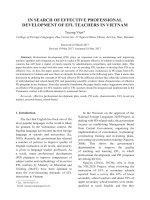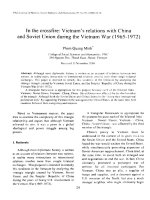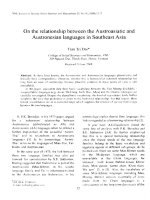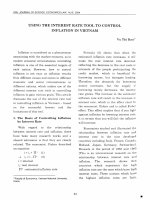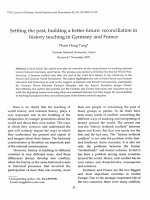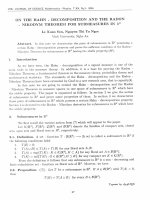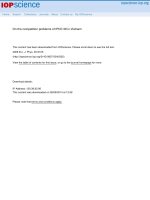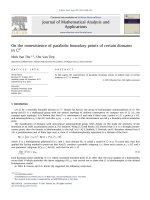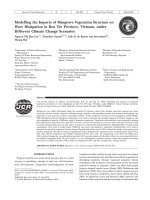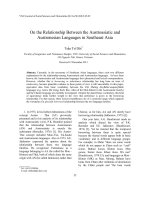DSpace at VNU: In the crossfire: Vietnam’s relations with China and Soviet Union during the Vietnam War (1965-1972)
Bạn đang xem bản rút gọn của tài liệu. Xem và tải ngay bản đầy đủ của tài liệu tại đây (1.64 MB, 13 trang )
VNU Joum al of Science, Social Sciences and H um anities 25, No.5E (2009) 24-36
In the crossíìre: Vietnam’s relations with China
and Soviet Union during the Vietnam W ar (1965-1972)
Pham Quang Minh*
College o f Social Sciences and Humanities, VNU
336 Nguyen Trai, Thanh Xuan, Hatioi, Viettĩatĩì
Receivcd 13 November 2009
Abstract. Although most điplomatic history is written as an a c c o u n t of relations between tvvo
nations, in reality niany interactions in international rclations involve morc than simplc bilateral
exchanges. This paper is intcnded to rcmedy this weakness in the litcrature by analyzing thc
strategic triangle created by Vietnam, Soviet Union, and the Pcoples' Repubhc of China during the
Vietnam War (1965-1972).
A tria n g u la r fra m e w o rk is a p p ro p ria te for ih is p u rp o se b e c a u s e e a c h o f th e b ila tc ra l lin k s -
Vietnam - Soviet Union; Vietnam - China; China - Soviet Union was affcctcd by thc third membcr
of ihe triangle. Although both the Soviet Union and China claimcd to be "cioing their intemational
proletarian duty" by supporting Vietnam in thc war against the United States, at the same time both
countries folỉowed theirovvn policy and interests.
Based on Victnam ese sources, the paper
tries to exam ine the com plexity o f this triangle
relationship and argues that, although Victnam
achieved its aim, it vvas a pawn in 2 global
ideological and pow cr struggle am ong big
powers.
1. R ationalc
Although m ost diplomatic history is written
as an account o f relations betw een two nations,
in reality many interactions in intem ational
relations involve more than simple bilateral
exchanges. This proposal is intended to rem edy
this vveakness in the liierature by analyzing the
strategic tnangle created by V ietnam , Soviet
Union, and the Peoplcs’ Republic o f China
during the years o f heavy U.S. involvement in
the Vietnam W ar (1965-1872).
A triangular íramevvork is appropriate for
this purpose becausc each o f the bilateral links V ietnam - Soviet Union; Vietnam - China;
China - Soviet U nion - was affected by thc third
m em bcr o f the triangle.
China^s policy in V ietnam must be
understood in the context o f its goals vis-à-vis
the Soviet U nion and the U nited States. China
hoped the w ar w ould weaken the United States,
vvhile sim ultaneously prcvcnting expansion o f
Soviet-A m crican rapprochem ent. China tricd, at
the same tim e, to avoid both an enlargcd war
and negotiations to end the war. In fact, China
ultim ately prom otcd a prolonged vvar o f
attrition for all involvcd parlicipants. For
Vietnam, C hina w as an ally, a supplicr o f
troops and supplies, and a deterrent against a
U.S. invasion o f thc Norlh, but also a much
stronger ncighbor w ho might ultim ately begin
P.Q. Minh / V N U Ịouninl p f Science, Soàal Sciences and Hitmanities Hunumitíes 25, No.5E /2009/ 24-36
to take advantage o f its great size to push
Vietnam into a clcarly subordinatc status.
In com parison to China and thc United
States, the Soviet U nion’s position on Vietnam
was more uncomfortablc bccause it was
inlluenccd by two coníìicting intcrcsts: a desire
to reach a detente with the U nited States, and an
interest to gain VictnartTs support in its struggle
with China. In general, Sovict policy tovvards
Vietnam
dunng
the vvar
had
several
dim ensions. Firsí, M oscow ilid not want to
sacnfice its stratecy o f dctentc in its rclations
w ith the u s . Second, M oscow w as ready to
provide all the necessary m ilitary and economic
aid n e e d e d for Hanoi to pursuc its war. Third,
M oscow prcferrcd negotiating a sctticmcnt to
the vvar rather than being draw n further into
It[ 1J. In other w ords, the S oviet U nion tried to
have greai iníluencc in V ietnam in order to
realize its foreign policy goals: to rcach an
appropriate settlem cnt to thc vvar and to make
the DRV a reliablc Sovict ally in thc world
com m unist movement.
In short, during thc w ar, V ictnam was a
pawn in a global ìdeological and pow er struggle
am ong the U nited States, C hina, and thc Soviet
Union. W hile C hinese interests \vould only later
becom e clear, both the Sovict U nion and the
United States clearly show ed their interests in
the V ietnam conílict for thc first tim c in 1950.
The U nited States íeared a rapprochem ent
betw een the tw o com m unist pow ers. China, in
turn, w as afraid o f a Soviet-A m erican dctcnte.
w hile the Soviet Union w as concem ed about
any im provem ent o f Sino-A m crican rclations.
2. T he E m e rg e n c e of th e tria n g le
The
G eneva
A ccords
recogm zed
the
baỉance o f these powcrs. B oth the Sovict Union
and C hina agreed to cnd the First Indochina
25
w ar, bul for diffcrcnt reasons. W hilc the Soviet
U nion prefcrrcd dctcnte with the United States
in order to kecp a status quo in Europe, China
tblloNvcd its Hve principles o f peaceíul coexistence in Indochina, with two Vietnams and
a protracted strugglc in the country’s South.
Howcver, both the Soviet Union and China
continued to support N orth Vietnam in
reconstructing its econom y, in order to build up
Vietnam as an “advance p o st” o f socialism.
China was a main supporter as well as a
beneficiary o f the G encva A ccords o f 1954[2].
On M arch 3, 1954, the C hinese N ews Agency
announced that C hincse govem m ent accepted
the invitation o f Sovict Union to participate in
the G eneva confcrcnce on Korea and
Indochina[3]. Jcan Chauvel called the Geneva
Conferencc as thc íirst m ceting betw een the
East and the W est with participation o f
Beijing[4Ị. R ealizing thc importance o f the
confcrencc China had preparcd very carefully,
and sent to G cneva a largc delegation o f 200
persons[5]. D uring thc G eneva conference,
Chou Enlai show ed his skills as a diplom at and
negotiator. B ased on the fact o f détente among
powers, China tried to pcrsuade Vietnam to
sign the G eneva A ccord by accepting a division
o f the country into tw o parts the N orth and the
South along the 16th parallcl. However, China
suggested that if France will not accept this
proposal, V ietnam w ould makc Hai Phong a
free port allow ing Francc to settle a certain
forces. In w orst case, Victnam could propose
that the H ighw ay N o 5 and Hanoi and Hai
Phong cities to becom e an arca o f common
conlrol and non-m ilitary purposes[3].
As a main ílgure in shaping the Geneva
agreem cnt, the Sino-V ictnam rclationship was
very close in thc sccond h a lf o f the 1950s and at
the beginning o f thc 1960s. A bout one year
aíter the G eneva conĩcrcnce H o Chi Minh led a
high ranking govcm m ental delegation from
26
P.Q. Minh /V N U Ịoum al o f Science, Soàal Sciences and Humanities 25, No.5E (2009) 24-36
Vietnam to pay an official visit to C hina from
June 24 to July 7, 1955. D uring this visit two
sides signed some agrcem ents on econom ic,
cultural and education exchanges. C hina also
agrecd to provide Vietnam w ith a grant o f 800
millions Yuan (200 m illion USD)[3].
In this pcriod, both C hina and Soviet Union
were o f the same opinion on Vietnam ese
revolution that DRV had to concentrate on
construction o f socialism in thc North o f
Vietnam. The consensus o f China and Soviet
Union was cxplaincd by several factors. First,
alter years o f conírontation thc intem ational
relations entered in the period o f détente
betvveen big powers. Second, both Soviet Union
and China wanted to take this opportunity to
c o n s o lid a te th e ir in te m a l affa irs. Third , the
conflict bctwccn Sovict Union and C hina still
did not appcar serious.
The harmonized relations betw een Soviet
Union and China were clear during the Geneva
confcrence. In a speech delivered on M ay 12,
1954, Chou Enlai relerrcđ to Soviet Union as a
guarantee for solving the conílict in Indochina:
“It is also necessary to m ention the peaceful
policy o f Soviet Union - Soviet U nion is alvvays
patient to sole the conílict in Indochina in
peaceful way, and to support the national selfdetcrm ination o f Indochinese people.”[3]. In a
tclcgram datcd o f M ay 30, and in a spcech o f
June 8, 1954, Choư Enlai m entioned again and
again about Soviet Union that shared the idca o f
China in the issue o f intem ational control in
Indochina aíìer Geneva coníerence. W ithout the
agreement betwcen Soviet Union and China,
the Geneva confcrence vvould have taken morc
time. It was Soviet U nion and C hina who
played an important role in settlem ent o f the
conílict in Indochina. N ot only in Vietnam ese
issucs, but also in solving thc questions o íL a o s
and Cambodia, both C hina and Soviet Union
shared the same idcas. The đifference w as in
the vvay that China dealt w ith Laos and
Cambodia. A ccording to C hina all parties,
including V ietnam , had to vvithdravv th eir íorces
from Laos and C am bodia. W hile, in Laos, the
revolutionary forces could m ove to the north oi
the country in the border arca vvith C hina and
Vietnam ,[3] in C am bodia, there was no di Vision
o f conlrolled area for revolution and national
forces[3].
Until N ovem ber 1956, the split betvveen
China and Soviet U nion had not em erged. The
relationship betw een tvvo countries becam e
worse as N ikita K hrushchev denounced Stalin
at the Tenth Party congrcss o f the Com m unist
Party o f the Soviet Union in early 1956. During
the visit o f C hinese govem m ent and
Com m unist Party o f C hina delegation led by
Chou Enlai to V ietnam on N ovcm ber 18-22,
1956, Chou Enlai had a long discussion vvith
Victnam ese leaders on several important
questions. First, according to Chou Enlai, the
recent intcm ational situation, especially after
events in Algeria and Hungary, became
seriously com plicatcd. The situatiơn in Hungary
and in other countries in Eastem Europe
shovved that, dcspite the fact that Soviet Union
invested many resources in Eastem Europe, but
the people there vvere still against Soviet Union.
The reason for their protest was, according to
China, Soviet hegem ony. Chou Enlai said: “The
principles o f M arxism -Leninism are universal
truth, but one cannot forcc a country to accept
these principles - One has to com bine with the
practice o f those countries.” [3] According to
Chou Enlai, C hina w as especially displeased
\vith hegem ony in the relationship between
countries. Although hegcm ony was not a major
trend. Chou continued, it existed in some
relations, and could iníluence badly on the
masses. Secotĩd, on the question o f Vietnam
unification, Chou advised Vietnam to follow a
protractcđ struggle. A ccording to Chou,
Victnam should regard the principle o f
reunification through free election as a slogan
P Q. Minh / VNU lounm l o f Science, Social Sciences and Hunmiúties Humanities 25, No.5K (2(X)9) 24-36
for political struggle. rathcr than as a guidcline
for daily actìon. D iscussing thc issue o f
economic policy, cspccialiy thc land reíbrm,
Chou was o f thc opinion that thc program was
esscntially succcsslul,
w hilc m istakes and
shortcomings Nvere isolated and local. Using
this opportunity Chou Enlai dcfcndcd Stalin
IVom the attack o f Sovict leadcrship: “Comrade
Stalin made scrious m istakes, but it is to
contìrm that in thc m ain his policics vvere the
coưect and victorious."[3].
In 1957, thc split bctw een Sovict Union and
China becam e more open. NVhilc dcfcnding
Stalin, China becam e criticize Soviet policy
tow ard building Socialism through focusing on
heavy ìndustry. In A pril 1957, Prcm icr Ministcr
Pham Van Dong lcd a delegation to visit China
to discuss on situation and plan o f dcvcloping
the North o f Vietnam. During a mceting with
Victnam ese collcagues on April 22, 1957, Mao
Zcdong advised: “C om rades, it wi!l be
dangerous if you go by the recent vvTong way o f
brothcr countnes in Eastem Europc. Hungary
madc m istake bccausc it docs not dcvelop
agnculture, because o f loo fast dcvelopm cnt o f
industry, developing w ithout a markct. Poland
has paid m uch attention to industry, while the
country did not have enough food, and even had
to ìm port to feed itself.” [3]. (It should be noted
thai, like the othcr countnes in Eastem liurope,
China had also followed the dircction from
Soviet U nion that m eans to focus on heavy
industry w ithout paying attention to rcsources
and m arkets. The results wcre a w asle o f 4
billions U SD [3].)
The othcr issue conccm ing both C hina and
Soviet U nion was how V ictnam csc revolution
in the South o f V ietnam should bc continucd. In
D ccem ber 1955 there w as a visit o f a delegation
frotn the M ilitary C om m ission o f thc Party
Central C om m ittec (Quan uy T rung uong) to
China. D u n n g the m eeting betw een tw o sides
27
on D eccm ber 8, 1955. D cng Xiaopm g \vas the
opinion that V ietnam had to prepare for a
prolonged war o f 10 or 20 years[3].
In general, in thc period from 1954-1963,
China
w ieldcd
cnorm ous
intluence
on
Vietnam csc dom estic issues. Following this
stralegy, Beijing tricđ to convince the Norlh
Vietnam to acccpt a dcfinitive division o f
Vietnani by advising it to consolidate thc
revolutionary achicvcm cnts in the North[6].
Unlike Chm a. thc Soviet Union recognized
the role o f Victnam csc rcvolution rather late in
its global stratcgy. Even aftcr 1954. Soviet aid
to Vietnam was far behind that o f China[7]. In
order to help Victnam to carry out the íìrst five
vear plan (1961-1965) Soviet Union provided
Vietnam a rcnt o f 430 million rubles with
íavorable conditions and anothcr 350 million
rubles to cultivate Iropical trees in agricultural,
state-run farms. In addition, a grant o f 20
m illion rublc was providcd for combating
m alaria[8]. Until 1964, with assistance o f
Soviet Union about 90 important projects were
renovatcd or ncw built up. Among these there
were projccts in thc íiclds o f hydroelectricity,
m ining, m cchanics, chcm istry, light industry,
and education. A ccording to Prem ier M inister
Pham V an D ong, thesc prọjects played very
important rolc in building up initial m atenal
and technical foundation o f socialism in
Vietnam[8].
A lthough Sovict Union continued helping
Vietnam in building up ihe country and íìghting
against A m erica, its assistance during this
period charactcrizcd as at “an indifferent level” .
There were no Sovict high ranking delegations
to visit Victnam . The highest official who
visited Vietnam w as M oukhidinov, Politburo
m em ber and Sccrctary o f the Central committee
o f CPSV who attcnd the Third Party congress
o f V ietnam ’s W orkers Party in 1960. Nikita
K hrushchev did not pay any visit to Vietnam,
28
P.Q. Minh / VNL1 Ịoum aì o f Science, Social Sciences and Hunuììĩities 25, No.5E (2009) 24-36
but had done so in Indonesia, Indìa, M yanmar
and A lghanistan during February and M arch
1960, dcspite the fact that Presidcnt Ho Chi
M inh extcnded an invitation to him severa!
tim es[8].
T he attitude o f Soviet U nion tovvard
V ietnam becam e worse in the m id-1963 after
V ietnam publicly statcd its opinion on
intem ational affairs and after thc visit o f Liu
Shaoqi in M ay 1963. Although thc Vietnam
W orkers Parly recognized the conílict betvveen
the Soviet U nion and C hina early on, It w as too
late in expressing its attitudes about the
problem . On Fcbruary 12, 1963, thrce years
after the conílict had opened, the polilburo o f
the V ietnam ’s W orker Party callcd the íratem al
parties to stop attacks against each other in the
m ass m cdia, and called for a m ecúng to solve
the disunity w ithin the w orld’s com m unist and
w orkers m ovem ent. T he silcnce o f thc
V ietnam ’s W orkers Party can be explained by
its w ish to w in thc support from both sides for
its o\vn struggle against thc
How ever,
silence was not alw ays the bcst policy. The late
reaction o f the V ictnam ’s W orker Party made
both sides unhappy, especially C hina, and vvas
criticized by Icadcrs o f other socialist
c o u n tn es|9 ].
M oreovcr “the politics o f
neutrality exacted a high pricc on H anoi’s war
eíĩort. [10].
us.
In M ay 1963, President Liu Shaoqi decidcd
to pay an o íĩicial visit to Victnam. The niain
objective o f this visit w as to discuss with the
V ietnam ’s W orker Party on the unity and
solidarity am ong socialist countries as well as
relationship betw een V ictnam -Soviet UnionC hina. B eíore going to Victnam, Liu raised
som e question to Vietnam cse leaders: why
there
is
disagrcem ent
am ong
socialist
countries? W hat is the charactcr o f this
conílict? C an this conílict bc overcom e? Is this
dangerous if the contlict will be continued?[8]
A lthough he stated that “ this visit is friendly
visit bccause tw o countrics are brothers and
socialist com rades," but in fact C hina critĩcízed
V ietnam ese attitudc to the split betvveen Soviet
Union and C hina, and askcd V ietnam to support
China in this conílict. Liu Shaoqi stated:
“ Let m e talk about principlc issue. 'I*he
problem s arise \vhcn therc is discussion on the
principles, there is n o m id-\vay and com prom ise
choice. T his is not attitude o f M arxism Lenimsm - Ít is nccessary to have a clear. stable
opimon on problem s, such as questions o f
p rin cip les...W e have never hcard Ihat you are
consistent in principle. T he unity vvithout
p rin c ip le 1S c o m p r o m is e . l l n i t y m u st b e b a s c d
on pnnciple o f M arxism -Leninism , o f the tvvo
M oscow statem cnts. C ontm uing unity w hile
refusing these principlcs wou!d be not
acceptable.” [8].
A ccording to V ictnam cse sources, during
the period bctw ecn 1960 and 1964, the Central
C om m ittce o f V ictnam ’s \Vorker Party rcceived
more than ten letters and announcem ents o f
Central C om m ittce and 1’olitburo o f CPSV
m entionm g Sovict-C hina split, and callm g for a
Soviet-V ietnam ese m eeling regarding bad
V ietnam csc attitudes toward Sovict cxpcrts in
Vietnam . M ore over, Central C om m ittee o f
CPSV
insisted
that
V ietnam
“change
vievvpoints'' (thay doi lap truong). In a meeting
with Le D uan, First Sccrctary o f V ietnam ’s
W orker Party in Fcbruary 1964, Khrushchcv
even thrcatened to cut o ff m ilitary assistance for
Vietnam [8].
In D ccem bcr 1963, V ietnam ’s Central
C om im ttee decidcd to call its N inth Plenum to
discuss dom cstic and intcrnational p o lic y [ll].
In the context o f dccpcned conflict betwecn
China and Soviet Union, Ho Chi Minh
rem inded thc participants to pay special
attention to the problcm o f unity betvveen
Vietnam and C hina, on the one sidc, and
P.Q. Minh / VN U Ịoum al of Science, Sociaỉ Sciences and Hunmnities Humanitics 25, No.5E (2009) 24-36
betvvccn Victnam and Soviet U nion, on the
other side, considering Ít to bc thc íìrst priority
o f thc V ictnam ’s W orker P arty's torcign policy.
Hc emphasized: “O ur goal is unity. For umty
wc ha ve to struggle. T o strugglc is to serve
umty, not to spcak badly about anyone. (VVc
m ust somc) hovv do so so that vvithin our party
and pcoplc thcre is lovc and gratitudc to thc
íratem al brothcr countries.”[ 12).
Hoxvcver, duc to diffcrcnces in stratcgics
bctw ccn thc VietnarrTs VVorkcr Party and the
Soviet Union, the relationship bctw cen V ietnam
and ihc Soviet U nion aftcr thc N inth Plcnum
bccam e vvorsc. V ietnam callcd its students
s tu d y in g social s c ie n c c s in thc Sovict Union
back to VietnanV . A ftcr thc N inth Plenum ,
sounng rclationshíps not only cxisted betw een
the tw o parties but also betvvccn thc tw o states.
The Soviet U nion had thrcatcncd and íorccd
Victnam to follovv its policy direction,
interfering in the intcm al politics and
sovcrcignty o f VietnamỊ 13]. In a letter datcd o f
July 6, 1964 thc Central C om m ittee o f CPSV
\vrote:
“ In recent tim e som e activities o f m cm bers
o f Central C om m ittee o f V ietnam ’s W orker
Party made us w orry and unhappy, bccausc
thcsc actions have clearly gonc in a contrary
direction to the statcm ent o f V ictnam ese
Thẽrẽ wcrc about one thousand studcnts w crc callcd
back to Victnam during 1963-1964. A ccording thc
intcrvicw conductcd by thc author in A ugusl 2004, all
studcnts (most o f thcm w cre second or third ycars studcnts
in ihc Sovict U nion) had to lcavc th c Sovict U nion for
V ictnam as soon as possiblc w iihout knovving w hcther
thcy could com e back to Sovict Union. T hcrcíorc, thcy
had to go back w ithout taking an>ihing with Ihcm A íìcr
a m vai in V ictnam , thcy faccd m any difficultics. T h cy did
no! know \vhat to do, and w hat to study. In co m p a n so n to
thc studcnts w ho cam c back from C h in a, Ihcy wcrc
ncglcctcd and did not rcccivc any support o r attcntion.
Until today these studcnts still havc an inícriority com plcx
and dissatisfaction. A m ong thcm thcrc vvcrc o n ly thrcc
pcrsons w h o could rctum !0 thc Sovict U nion, and íìnished
thcir study thcrc. A m ong thcsc lucky pcrsons, thcrc w as
Dang X uan Ky, thc son o f Truong Chinh
29
delegatcs on Soviet-V ietnam fricndship. A
recent uníncndly cam paign against Soviet
U nion \vas carricd out morc and m ore w idely
and actively within D cm ocratic R epubhc o f
Vietnam . In secrct m cctings o f the Party and
am ong
population
thcrc
w as
a
vvidc
dissem ination
o f falsification
to sprcad
suspicions about the country o f Lenin, to stir
bad sentim ent tow ard thc country o f Lenin.”
The letter concludcd: “ Rightly wc believe that
íriendship
m ust
bc
rcciprocated
with
fhendship.” [8].
In short, thc trianglc V ictnam -Soviet-U nion
relations werc vcry com plicated and covered by
intem ational, rcgional and intem al íactors. This
relation also reĩlcctcd the split in relationship
betvvecn Soviet U nion and China. B oth o f them
tricd to have morc inllucnces on V ietnam , and
used this for their purposes.
3. T h e trỉa n g lc in th e p crio d o f 1964-1968
The ycar o f 1964 w as a tum ing point in the
triangle rclations bctw ecn V ielnam -Soviet
Union-China. There wcrc som e reasons to
explain this change. F irsty in O ctober 1964,
K hrushchev w as rcm ovcd from the position o f
the First Secrctary o f thc C PSV by Leonid
Brezhncv. Second, thc escalation o f the
V ietnam W ar forccd Sovict U nion and othcr
socialist countries lo provide m ore assistance
for Victnam . Third, thc com plexity and incrcase
o f conflict betw ccn Sovict U nion and C hina
iníluenced grcatly on V ietnam —the third parly.
The Victnam policy o f Soviet U nion was
m odified in thc Brczhnev cra.
C hinese aid to N orth V ietnam increased
dram atically evcn after 1963. T here vvere a
num ber o f rcasons for this increase. First, the
escalation o f m ilitary conílicts in South
Vietnam lcd to an cxpansion o f the w ar to
N orth V ictnam and dccpcned C h in a’s fear that
30
P.Q. M inh / V N il Ịournnì o ị Science, Sociaỉ Sciences and Hurm nities 25, No.5E (2(X)9) 24-36
the war could threaten its security. Thereíbre,
China dccidcd to o íĩc r additional forces,
consisting o f 230 battalions, to North
Victnam[2Ị. Second, M ao uscđ the intem ational
situation and support to Vietnam to win the
upper hand in an intem al strugglc for povver
among C hincse Com m unist Party leaders.
Third, C hina’s m otivation for increasing
support to Victnam was rclatcd to the split
betw ecn China and the Soviet Union that took
placc in 1956 after the 20lh C ongress o f the
Sovict Com m unisl Parly. Through its support to
Victnam, thc Chincsc leadcrship tricd to shovv
that China was the country that could provide
Vietnam with suíĩìcient support for its national
libcration movcmcnt, and that C hina w as a Irue
com m um st country. in com parison to Soviet
Union. Fourth, C hina’s support to Victnam can
also bc cxplained through its desire to play a
lcading
rolc
in
hclping
rcvolutionary
m ovements in thc third vvorld. In sum , through
support to Vietnam, C h in a’s leadcrship tried to
achicvc both intcrnational and dom cstic goals.
As part o f this proccss, during A ugust 1964,
China cam cd out changcs to its military
presencc in thc South o f China, such as the
redcploymcnt o f its air forcc and anti-craft
artillcry, as well as thc construction o f new
airportsỊ 14]. In political and social life, there
was a trcm cndous movemcnt know n as “ Resist
Am erica and Assist Vietnam " which was
organizcd throughout thc country w ith the
parlicipation o f morc than 20 m ilhon people(2).
In latc 1964 and carly 1965, China even madc
clear that it was rcady to scnd its arm y to fight
together with thc Victnamcse pcople, and that it
would offer all rnanner o f support to Victnam (3).
In the pcriod 1964-1968, China*s supporl to
Victnam was cxpresscd in thrcc main forms: the
construction and m aintenance o f deíense
^ Rcnmin ribao (1965), 7 and 12 August.
(ỉ) Rcnmin nbao (1965), 25 March.
inírastructurc, air íĩclds, roads and railvvays; the
use o f C hinesc anli-aircraft artillery troops in
the dcícnse o f imporlant strategic areas of
North V ietnam ; and the supply o f military
equipm ent and civil m aterials. A ccording to onc
statistic, o v cr 320,000 C hinese cnginccring and
anti-aircralì artillcry forccs w ere in Vietnam at
the tim e[ 15]
In com parison to ihe previous period,
during 1964-1968, Sovict U nion had m odified
their policy towarđ V ictnam . The nevv
lcadership o f Sovict Union has reconfìrmed
their role o f co-chair íbr G eneva conlercnce
1954 for V ictnam . The lcttcr o f M inister o f
Foreign A ftầirs G rom yko to M inister Xuan
Thuy datcd o f D ccem ber 12, 1964 stated: The
states participating in Geneva conícrcnce could
not be oulside, vvhcn security o f nations and
peace in Indochina vvas thrcatcnccl.,,
The tum ing point in thc relationship
bctvvecn the Sovict Union and N orth Victnam
was in 1965 when Soviet Prem ier Kosygin
visitcd H anoi in early February. The mcaning
o f the visit w as m ultidim cnsional. Firsty the
Soviet U nion w anted to makc clcar its eíĩorts to
đcfend lỉan o i from A m erican air attacks by
eqưipping ihe DRV with anti-aircraíì vveapons.
Second, thc Soviet U nion vvanted to c m p h a s iz e
its position in Southeast Asia. Third, the Soviet
Union intcnded to w am Victnam not to
undcrestim atc
the
us
plans
regarding
com m unism in Asia. L ast bui not ỉeast, the
Soviet U nion planned to comc to an agrcement
with Chincse lcadcrship on thc Vietnam W ar,
taking into account K osygin’s two visits to
Beijing[16].
D uring this pcriod, Sovict Union vvas
intcndcd for V ictnam a strong politica! support.
On May 8, 1965, thc First Sccretary Leonid
Brezhncv stated: “T o support Victnam in the
strugglc against aggrcssion o f American
impcrialism is an honorahlc cause, and vital
P.Q M inh / VN U Ịournal o f Science, Soàal Sciences and Humanities Humanities 25, No.5E (2009) 24-36
31
intcrest o f all people deíending íreedom and
indcpcndcnce.” [8]
íratem al
solidarity
and
socialist
intem ationalism during M arch 1965[4].
Soviet Union also established official
rclations vvith National Liberation Front (NLF).
On January 13, 1965, thc representative offìce
o f N LF was founded in M oscow . In M ay o f
1965 this offĩce gained diplom atic status. On
lune
13, 1969 Soviet U nion offĩcially
recognized
Provisional
R evolutionary
Government o f Rcpublic o f South Vietnam
(PRG).
The high point o f the cooperation between
the Soviet U nion and Vietnam was the official
visit o f the V ietnam 's W orker Party delegation,
headed by Le Duan, to M oscow from April 10
to 17, 1965. In the jo in t com m uniqué draíìed by
the end o f the visit, both sides stated: “ If the us
intensifies its aggression against the DRV, in a
necessary case and i f the DRV requires it, the
Soviet U nion govem m ent would permit the
departure to V ictnam o f those Soviet citizens
who expressed their w ish in accordance with
the feelings o f intem ational proletarian spirit to
struggle for the ju st cause o f Vietnamese
people, for defense o f socialist achievcm ents o f
the DRV ” [17]
In term o f economy, like during the
previous period, Soviet support continued
playing an important role. In February 1965,
Soviet Union decided to defer Vietnam ese
debts.
A fter the visit o f K osygin, S oviet aid to
Vietnam increased every year. Hovvever,
Moscovv (lid not want to risk its relations with
the u s and the W est. As a result, M oscow ’s
foreign policy was in a dilem m a. O n the one
hand, the Soviet Union had to show its
intemational prolctarianism to its V ietnam ese
fricnds. On the other hand, it did not like to
block its com m unication w ith the W est. In
addition, the m eeting vvith C hina did n o t bring
positive results. China rcíused to coordinate
support to V ietnam . All these factors gave an
im p r e s s io n that the Soviet U nion, despite its
statement to support V ietnam , still tried to
avoid involvem ent in the V ietnam c o n ílict and
to cooperate w ith the u s in m aking a political
settlement.
From M arch 1965 on, due to the escalation
o f the w ar and the failure o f a diplom atic
settlemcnt to the conílict, M oscow decided to
strengthen cooperation w ith V ietnam in
economic and m ilitary areas. Soviet aid was
mostly in form o f food and equipm ent, and was
transported initially by sea, but after M arch 30,
1965 through C hinese territory. Soviet leaders
made several sừong public statem ents on
As a result, the Soviet Union agreed to
provide Vietnam with surface-to-air missile
batteries for the area around Hanoi, Hai Phong
and other im portant cities, in addition to fighter
aircraft, pilots, and technicians. The April 1965
visit also solved problem s o f the transportation
o f Soviet aid through C hinese teưitory. The
íìrst fifteen M IG 15/17s and one hundred
arm ored personnel carriers were sent to
V ietnam . Later som e light IL-28 bombers
arrived in Vietnam as well[[7].
D uring 1965 both W ashington and Hanoi
were in no hurry to negotiate, preferring to gain
m ilitary victories, and then to negotiate from a
position o f strength. Thereíore, during 1965 the
w ar in Vietnam approached a nevv and
dangerous phase, though there vvere several
attem pts to prevent it. The Soviet U nion was
the only m ediator that could negotiate a
settlement, b u t it íailed to do so because such a
settlem ent could isolate the Soviet Union from
coĩnm unist and national liberation movements.
Soviet aid to V ielnam grew steadily from
1965 to 1968. By 1967 total socialist-country
aid to the DRV accounted for about 1.5 billion
32
p Q. M inh / V N U Ịournnì o f Science, Sociaỉ Sciences and Humanities 25, No.5E (2(X)9) 24-36
rubles (more than 1.5 billion USD), among
vvhich M oscow ’s share was 36.8 percent (608
million USD). By the cnd o f 1967, Soviet
supporl grcw to 50 pcrccnt o f total socialistcountry aid. Among this, m ilitary aid comprised
two-thirds o f all Soviet assistance, and
accounted for 396.7 m illion USD in 1968. In
addition in Septem bcr 1965 thcrc vvcrc betwecn
1,500 to 2,500 Sovict m ilitary pcrsonnel
serving in V ietnam . T hey w ere m ostly
tcchmcians, pilots and SAM opcrators. In
addition thcrc vvas a spccial group rcsponsible
for obtainm g sam plcs o f American vveapons to
lcam about up-to-datc u s arm s[7]. In 1968, the
Soviet Union took ovcr thc top position in
supporting Vietnam from China. HoNvever, it
was a bitter m om ent for the Soviet Union,
according to one rcport from thc Soviet
em bassy in H anoi, as the Sovict U nioi^s
ìníluence in Vietnam did not grow accordingly
\vith their support.
By 1965, faceđ with escalation o f the war in
Vietnam and sim ilarly cscalating com m itm ents,
the Sovict Union proposed a plan to unify
activities among socialist countries to support
Vietnam. This plan w as t\vofold: to strengthen
support for Vietnam, and at the same time to
put China in on the defensivc. D uring his visit
to Vietnam in Fcbruary 1965, Prcsident
Kosygin suggestcd
that thrcc countries
Victnam, Soviet Union and China issue a
common statem cnt on a uniiìed plan.
Suggestions on a com m on statcm cnt o f socialist
countrics regarding Victnam made by Soviet
Union on January 12, 1966 and in March 1967
vvere again rẹịected by China.
The split betvvecn Sovict U nion and China
has badly influcnccd on transportation o f aid
goods from Sovict Union and other socialist
countries through C hinese tcrritory. Using its
position as a transit tcrm inal, China tried to
manipulatc this aid to lim it big m ilitary attacks
by thc V ictnam csc. Bcginnm g in 1965, Soviet
U nion suggcstcđ a scrics o f plans, su ch as the
cslablishm cnt o f a n air basc for S ovict airplanes
in H ainan province, or cstablishnìcnt o f airbridgc through China, using H oa N an porl to
scnd Sovict goods to V ietnam , o r organizing a
specialisl group in Binh T uong. Iỉo\vevcr, all
these initiatives o f Soviet U nion w ere rcjcctcd
by China[8].
In the context o f the dccp split bctvvecn
Soviet U nion and China, the atm osphcre o f the
triangle relationship was charactcrized by
distrust. Both China and Sovict U nion vvere
w orried about thc position o f Vietnam.
A lthough Soviet Union providcd V ietnam with
hea\ 7 support during this period, it w as still
w o m cd that V ictnam vvould m o ve from thc
Sovict side to Chincse onc. T he S ovict Union
was o f thc opinion that V ietnam w as biascd
tow ards
C hina.
During
high
ranking
ncgotiations in A ugust 1966, the Sovict Union
did not hesitate to raise questions regarding
vvhat C hina had advised V ictnam to do, and
w hat V ietnam had agreed w ith C hina. Sovict
Union also suspected that V ietnam w as too
depcndcnt on C hincse International policy, and
that V ietnam had scparatc talks w ith C h im to
oppose ihc Sovict Union. M orc over, according
to the Soviet U nion, V ictnam had treatcd Soviet
specialists coolly, prevented V ietnam esc pcoplc
from contacting thc specialists, and limited thcir
travel. V ictnam did not allow Sovict spccialists,
but rathcr C hinese ones to visit a missilc basc
that had bcen built by thc Soviet U nion. Also,
V ietnam , according to Sovict U nion, w as silcnt
when China slandercd thc Sovict Union[8].
All thcsc inHucnccd badly on relations
betw ecn the Sovict Union and V ietnam . The
Soviet U nion required V ietnam to make clear
choice: total depcndence on Sovict Union, or
continucd dcpcndcncc on C hina. It vvas not
surprise that Soviet Union did not confirm
P.Q. Minh / VNL1 ịo u rm l o f Science, Sociaỉ Sciences and Humanities Hunuinities 25, No.5L <2009) 24-36
additional aid for 1968 as wcll as m ilitary and
economic aid for 1969, with the cxplanation
that the rcqucst Irom V ietnam was so high that
they needed lime to consider|8|.
In short, in the pcriod o f 1964-1968, both
big brothers wcrc com peting to assist Vietnam
in the vvar against the u s . Sovict sources
claim ed that Victnam csc sym pathies toward
China vvere stronger than thosc tow ard the
Soviet Union. T he reason for this w as that
China remamed an im portant supplier o f
econom ic and hum an rcsourccs for Vietnam.
China was also closer to V ictnam ihan any
oihcr socialist country in geographical and
ideological tcrms. The Soviet Union tricd to use
every channel to cxploit disagrccm ent between
China and V ietnam for its ovvn interests.
Although both C hina and the Soviet Union
were ihc supporters ol'V ietnam , ncither o f them
vvas satisiìed w ith thcir V ietnam esc íriends. In
order to placate thc C hinese as wcll as to lieter
thc Sovicts, Vietnam dccided to arrest a group
o f high ranking officials supposed to be proSoviet in 1967. T hcy wcrc accused for treason,
espionage and transm itting State secrets [10].
This campaign w as kno\vn as the “ Revisionist
Anti-Party AíTair.” The arrcsts o f these persons
ihow ed on the one hand that the V ietnam ’s
VVorkers Party w ould not fall into the sphere o f
iníluence o f M oscow , w hile on the other hand
affirming V ictnam ’s continued policy o f
neutrality in thc Sino-Soviet split.
4. The Triangle in thc last pcriod of the war
(1968 1973)
The year o f 1968 w as tum ing point in the
Vietnam W ar. Inilucnccd by thc T et offensive
n January 1968, on O ctobcr 3 1 ,1 9 6 8 President
íohnson ordcrcd thc ccssation o f bom bing in
sỉorth Vietnam [18].
33
During this pcriod, Soviet Union continued
assisting Victnam to íìght America on the one
hand, and tried to play a rolc o f m cdiator in
V ietnam -USA negotiation. In doing so, Soviet
Union from the bcginning tried to persuade
Vietnam to acccpt thc "low conditions” raised
by America. O n January 28, 1967, M inister o f
Foreign A íĩairs Nguycn Duy Trinh made a
statem ent saying: “Only aíter America stops
bom bing unconditionally and ccases any other
vvarlike actions against the Democratic
Republic o f V ictnam , can the DRV start talking
w ith A m erica about rclatcd problem s.” [19). The
Soviet Union respondcd that America would
hardly accept to stop bom bing unconditionally,
thus preventing ncgotiations. A ccording to
Soviet Union, it w as an unrealistic conđition
raised by V ietnam . The Soviet Union asked
Vietnam to m eet somc requircm cnts o f USA.
N egotiations m ust bc bascd on thc reciprocity
principle, thereforc N orlh Victnam should stop
íĩghting in South V ictnam , and North
V ietnam ese forccs should w ithdraw from South
Vietnam . O n April 25, 1968 Kosygin said to
Prem ier M inister Pham Van Dong: “O f course,
America cannot stop bom bing North Vietnam
100% if they have achicvcd nothing. Surcly
they w ill require you to stop your support o f
ừoops and w eapons for South V ietnam , if only
on the su rfa ce ...If you firm ly required that the
us stop bom bing N orth Vietnam totally and
unconditionally, and you will not compromise
on anything, this is an ultimatum. But a real
vvillingness to negotiate requires all parties to
stop issuing ultim ate.” [8]
Regarding thc placc o f ncgotiations, Soviet
Union also tricd lo persuadc Vietnam to accept
Soviet proposal. At thc beginning o f 1968,
Soviet U nion proposcd to m eet in Moscovv or in
W arsaw. In April 1968, Sovict Union advised
Prem ier M inister Pham V an Dong during his
visit to Moscovv that N orth Victnam and
A m erica could m eet on a Soviet m ilitary ship.
P.Q. Minh / VN U Ịournal of Science, Social Sciences and Humanities 25, No.5E (2009) 24-36
34
In May 1968 the Soviet Union proposed that
North Vietnam and America to meet at the
Soviet Embassy in Paris. On June 13, 1968 the
Central Com m ittee o f CPSU sent to Central
C om m ittee o f VW P a letter in w hich contained
"packagc solutions.” On O ctobcr 19, 1968
Soviet Union again asked that Vietnam to
inform the Soviet Union o f V ietnam ese opinion
on the proposal. On October 25, 1968, Soviet
Union even prepared a draft o f statement
betwcen Vielnam and America on issue o f
stopping
the
negotiations[8].
bom bing
and
starting
Aparl from these cam paigns, Soviet Union,
according to North Victnam, still used aid as an
instrument in relations bctvveen N orth Vietnam
and Soviet Union. In 1968, the Soviet Union
provided an am ount o f additional m ilitary
supporl that w as lcss than Vietnam ese demands.
M orcovcr, Sovict U nion delayed m ilitary aid
for two months, and dclaycd in signing the
agrccm cnt on aid for the year o f 1969. In 1972,
Soviet Union had not only rẹịected Vietnam ese
đemand to reccivc President N ixon, but also
stoppcd m ilitary support for Vietnam.
The reasons that Soviet U nion followed
such
K ind o f p o l i c y
w ere
vcry
co m p lic a te d .
First, Soviet U nion may have overevaluated
American m ilitary strcngth o f USA, while
distrusting V ictnam cse m ilitary capability. In
the meeting vvith Prcm icr M inister Pham Van
Dong on June 3, 1966 Brezhnev said: “There
arc two ways to libcratc thc South: m ilitarily
and by negotiations. If vve uscd the first way,
wc do not have cnough forces. A m erica can
increase solders and easily provide assistance,
while m ilitary forces o f N LF are m ostly from
North"[8].
Secotưỉ, Soviet U nion w anteđ to avoid
direct, face-to-face talks with Am erica. O n May
4, 1966, A m bassador Tscherbakov said to
Pham Van Dong: “W e do not like the situation
o f having direct face-to-face ncgotiations with
Am erica.”
Third, Sovict Union w anted to use V ietnam
contlict to havc déíeníe vvith A m erica to serve
Soviet strategy. In the first official statcm ent on
Novem ber 6, 1964, B rczhnev said: “ Soviet
Union is ready to dcvelop Soviet-U S relations
for thc interest o f thc two pcoplcs and for the
ìnterest o f C o n s o l i d a t e d peace” . From M arch to
M ay 1965, Soviet security íorces supprcssed
dem onstrations against A m erican aggression
organizcd by V ictnam csc studcnts in Moscovv
and Leningrad[8].
Fourth, aftcr the Tct offensive, President
Nixon decidcd lo follow the V ictnam ization
strategy, announccd on July 25, 1969.
According to this strategy, USA changed its
strategy from confrontation to negotiation vvith
both China and Sovict Union, vvith the hope o f
escaping from thc V ietnam conílict. After
Vietnam started negations w ith the USA, the
Soviet Union ratiíìcd a consular notc vvith the
u s on August 13, 1968. T he N PT was signed
by Soviet Union and the u s on July 1, 1968.
The peak o f this deíeníe vvas thc visit o f
President Nixon to Moscovv in M ay 1972, even
w'nile u s torpcdoes vvere arrayeđ aiong
V ietnam 's coasts.
Last but not least, thc C hina factor played
an important rolc in V ictnam conílict. ỉn 1970,
Soviet Union tw ice askcd C hincse govem m ent
to have a m eeting on high levcl to discuss about
world situation and cxpansion o f the war in
Indochina. Soviet Union statcd that “the
coordination o f activities betw cen Soviet Union
and China, two big socialist countries, the voice
o f w hich will influcncc the American
govem m ent, can contribute !o the defeat
American
aggression
in
Indochina.” [8]
IIowever, C hina rcfuscd to cooperate with
Soviet Union. R esponding to Sovict suggestion,
Chou Enlai said: “The comm on action to
P.Q. Minh / VNU Ịournaỉ o f Science, Sociaỉ Sciences and Humanities tìum anities 25, No.5E (20()9) 24-36
support people o f Indochina and Vietnam
depends on relations between Soviet Union and
China, and on the [resolution o f the] split
betvveen two countries.” [8]. In addition, on
March 16, 1971 Chinese M inister o f Foreign
AíTairs stated: “ Soviet U nion and China ha ve a
principle
disagreement
about
American
attitudes; thcreíore China cannot act togethcr
vvith Sovict U nion.”[8].
The tuming point in the triangle happened
in 1971, as China started looking for a
rapprochem ent vvith the u s through “ ping pong
diplom acy” in April, and H enry K issinger paid
a visit to China in July o f the sam e year.
Responding to this dcvelopm ent, the People
Newspaper - an organ o f VietnarrTs W orker
Party- published an article w ith the title “The
N ix o n
d o c trin c
vvill
be
c e rta in ly
d e íe a te d ” .
Soviet Union revealed that there w as also
serious split betw een V ietnam and China. The
Soviet press decided to republish the article
from The People’s N cwspaper. In a mecting
vvith Prcm icr M inister Pham V an Dong on May
9, 1971, for thc first time, B rezhnev was o f the
opinion that Victnam m ust be thc core o f
leadership
in
Indochina
and
Southeast
Asia.”[8]. This idea was repeated several times
during 1971.
In 1972, when President N ixon was
preparing to visit China, the Soviet U nion tried
lo prevent the possibility that the us and China
:ould make com prom ise on V ietnam . On
February 12, 1972, A m bassador Tserbakov
mect Pham Van Dong to inform Vietnam ese
Premier M inister o f the Soviet opinion that the
ư s w anted C hina play the role o f mediator.
iỉowever, the Soviets felt that only Vietnam
rould undcrstand how to negotiate in Paris, and
hus the Soviet U nion w ould support V ietnam ’s
itandpoint. The Soviet U nion had also an idea
hat us vvould like, through Peking, to
;onsolidate its position in Indochina. Thereíbre
hc visil o f Prcsident Nixon to B eying? w as a
35
reaction o f the Soviet U nion’s protest o f the
rapprochem ent betw een us and China. The
C hinese íactor was in fact catalysis for SovietVietnam, and Soviet-ƯS relations dunng this
period.
5 . C o n c lu s io n s
The
developm ent
o f the
tnangular
relationship am ong V ietnam , China, and the
Soviet Union during the Vietnam W ar was a
classic exam ple o f C old W ar politics. In this
game, all o f them tried to win over the other
with different m eans and m ethods to further
thcir own interests.
In the context o f the C old W ar, where in
this case the game was being played on
Vietnam ese territory, the V W P was in an
uncom íortable situation. For the Party, the most
important
task
w as
to
gain
national
independence, íreedom and the reunification o f
Vietnam . In order to do so, the VW P tried to
carry out an independent íbreign policy on the
one hand, but also to gain as much support as
possible from both “ íratem al countries” on the
other. These two tasks were closely relatcd with
each other. In reality, V ietnam could not have
an independent policy because it needed the
support from within the socialist camp. And the
more support V ietnam received, the more it
depended on its alliances. So one can say that
the policy o f the VW P was shapcd and
determ ined very m uch by the balance o f powers
and the bipolarity o f intem ational politics. Both
C hina and the Soviet U nion claimed to be
shovving intem ational proletarianism through
their support to V ietnam , but in fact they were
trying to defend their own interests. The
rapprochem ent betw een the us and China and
between the us and the Soviet Union in 1972,
and the Paris A greem ent in 1973 were evidence
o f the continuation o f their approach tovvard
Vietnam.
P.Q. Minh / VN U Ịourììal of Science, Soãal Sãences and Humanities 25, No.5E (2009) 24-36
36
Reíerences
[ 1] Pike D ., Vietnam a n d the Soviet Union Anatomy
o f an Alliance, B ouldcr: W cst vicw Press, 1987.
[2] C hen Jian , “ China*s Invo lv cm cn t in th c V ictnam
w ar, 1964-1969” , The China Q uarterly , N o 142,
1995.
[3] Bo N goai giao, V u T ru n g Q u o c (M O FA ,
D epartm ent for C h in a ) (1 9 8 1 ), Ho 50 quan he
Viet-Trung trong g ia i doatì chong M y cuu nuoc
3/1953 (ỉen 8/1973 (T h e Filc o f V ictn am -C hina
R clatio n s d u n n g th c p c n o d o f A n ti-A m cncan
R csistan cc for co u n try salv atio n from M arch
195410 A ugust 1973. 1981.
[4] C hauvcl J.t C om m entaire . P a n s Fayette, V ol. III,
1973.
[5] Joyaux F., Trung Q uoc va viec giai quyet cuoc
chien tranh Dong D uong lan thu nhat (C hina
and thc S olvc o f th c First In d o ch in a W ar),
H anoi: N X B T h o n g tin Ly lu a n , 1983.
[6] Bo N goai giao, (M in istry o f P orcign A ffairs o f
thc D R V ) (1979), Su thai ve quan hc Viet NamTrung Quoc trong 30 nam qua (T h e T ruth about
V ietn am -C h in csc R clatio n s o v c r th c Past T hirty
Y cars), H anoi: M O F A , 1979.
Tct O íTcnsivc, Jo u rn a ỉ o f \'ietnam ese Studies ,
V o l.l.N o 1-2(2006).
[11] Ban chap hunh T ru n g u o n g D an g C o n g sa n Viet
N am (2 0 0 3 ) (T h e C en tral C o m m ittc c o f C PV )
(2003), Van kien D ang Toan ta p y T .2 4 , 1963
(C o m p ỉd c W orks o f P a rty ’s D o cu m cĩits, Vol.
24, 1963, H anoi. N X B C h in h tri Q u o c gia.
[12] V icn N ghicn cuu C h u n g h ia M ac-L cn in va Tu
tu o n g H o C hi M inh (In s titu tc for S tu d ic s o f
M arx ism -L cn in ism
and
Ho
C hi
M in h 's
Idcology) (1 9 9 6 ), H o C hi Minh bien nien su,
T ap 8 (H o C hi M in h ’s h isto n c a l chro n o lo g y ,
V ol. 8), H anoi: N X B C h in h tri Q uoc g ia , 1996.
[13] C u c Luu tru V an p h o n g T ru n g u o n g D ang
(1 9 6 4 ) (T he A rc h iv c o f th c C entral O ÍTice of thc
Party) (1 9 6 4 ), D e cu o n g bao cao ve tinh hinh
hoaỉ donR cua cac /)ư /ig p h e xa hoi chu nghĩa
trong cuoc đau tranh RÌua 2 duong lo i trong nam
I964% phong so 82, D on vi b a o quan 129
(Proposal o f rcport on a c tiv itic s o f th c parties in
thc socialist c a m p d u n n g th c stru g g le betw een
tw o w ays in 1964, F o n d N o 82, U nit 129), 1995.
R., An International H istory o f the
Vietnam IVar, V o l.2 : T h e S tru g g lc for Southcast
[14] Sm ith
A sia, 1961-1965, L on d o n : M acm illan , 1985.
[7] G aiduk I., The Soviet Union a n d the Vietnam
War , C hicago: Ivan R. D cc, 1996.
[ 15] W cm cr J., D avíd I lu n t (c d s.), The Am erican War
in Vietnam, Ithaca: C o m c ll U n iv crsity Southcast
Asm P rogram , 1993.
[8] B o N goai giao, V u L icn X o (M O FA ,
D epartm ent o f S ov ict U nion) (1 9 8 5 ), Ve quan he
[16] P ortcr
Viet-Xo trong giai dơơn chong M y cuu nuoc tu
thang 7/Ì954 den ihang 4 nam 1975 (O n
V ietnam -S ovict U n io n R clatio n s d u rin g the
p c n o d o f A n ti-A m crican R csistan cc fo r country
salvation from Ju ly 1954 to A p n l 1975, 1985.
[9] C uc Luu tru V an p h o n g T ru n g u o n g D ang (The
A rchivc o f th c C en tral OíTicc o f th c Party), So
ket van d e doan ket quoc te gan d ay , p h o n g so
8 2 , Don VI bao quan 129, P rc lim in a ry Su m up o f
th c cu rĩc n t d isu m ty problcm , F o n d N o 82, Unit
129: 83-84).
[10] N guycn L-H T ., T h e W ar Politburo: N orth
V ietn am ’s D ip lo m atic and P olitical R oad to the
G . (c d .), Vietnam: The Dẹfìnitive
Documcntation o f ỉỉu m a n Decisioỉis f Vo!.II,
N cw Y ork. 1979.
[17] Bo N goai g ia o nuoc C H X H C N V N ,
(The
M O FA o f S R V ) (1 9 8 2 ), Viet Nam-Lien Á o-30
nam quan he. 1 9 5 0 -1 9 8 0 (V ietnam -S ovict
U n io n , 30 y cars rc la tio n sh ip , 1950-1980),
M oscow : N X B T ic n b o , 1982.
[18] G cttlcm an M . ct all (c d s.), Yietnam
Am erica , NY: G ro v c P ress, 1995.
and
[ 19] N guycn D .T ., M at tran N goai giao thoi k)> chong
M y cuu nuoc 1965-1975 (T h e D iplom atic Front
d u n n g thc p c n o d o f A n ti-A m cn c a n R csislance
for co u n try sa lv atio n ), H a n o i, N X B Su Thai,
1979.
